|
|

The lead photograph is a vertical mine
shaft that leads to the famous gold vein in Dahlonega, Georgia.
What famous gold vein? Dahlonega is an unusual tourist town that
will introduce you to some unusual southern history which
includes some of the nation's earliest gold mining history.
As an example of what I mean by unusual, that mine shaft
is in a family-style restaurant, The Smith House, located a
block off the town's main square. During renovations workers
found the shaft in the restaurant's basement. Not all the
attractions in town are free, but viewing the mine shaft will
cost you nothing.
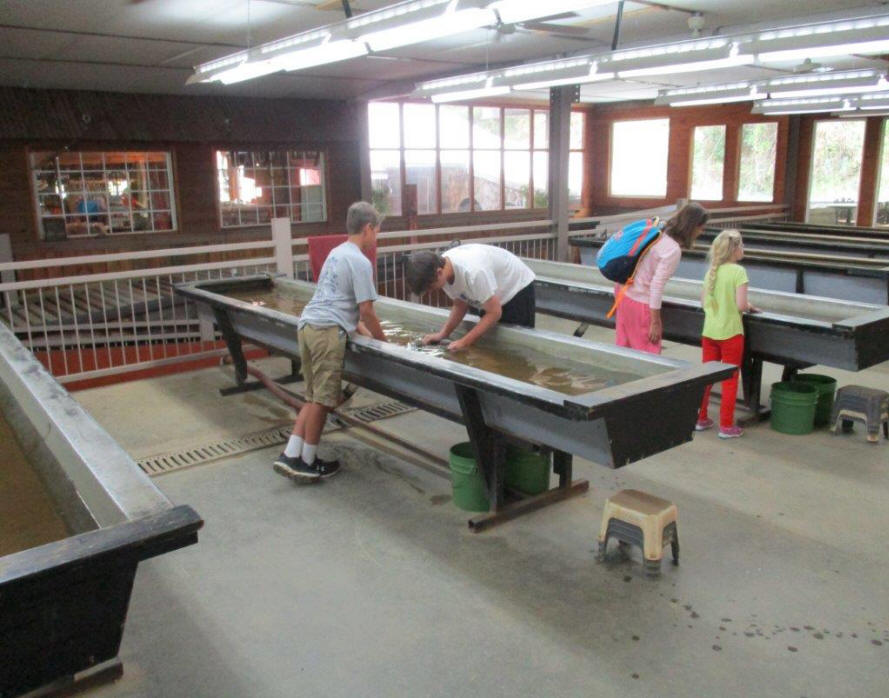 |
| The mine tour includes an
opportunity to pan for gold and gems. |
"There's gold in them
thar hills" conjures up images of the American West and probably
the 1849 California gold rush. But the phrase likely originated
in Georgia. In the late 1840s the assayer of the United States
Mint in Dahlonega attempted to persuade local gold
miners not to leave for California by intoning, "Why go to
California? In that
ridge lies more gold than man ever dreamt of. There's millions
in it." Many of the Georgia prospectors could not resist the
California bonanza and remembered the assayer's plea as they
scoured the California hills for gold. That plea developed into
the incantation, "There's gold in them thar hills."
And, yes, there was a U.S. mint in Georgia and America's
first gold rush was in the South, not the West!
A common misconception is that the first
American gold rush occurred on the American River in California
in 1849. Prior to that, there was a "Southern Gold Rush"
centered on the Piedmont of the Appalachian South that lasted
from roughly 1828-1836. "Gold excitement" began in North
Carolina in the early nineteenth century (see the "Gold Trails:
The Reed Mine" in the Summer 2012 issue), with most gold seeking
being a part-time activity of local farmers.
By 1828 the region had a
large population of full-time prospectors, fully aware that
other gold strikes were likely in the Appalachian foothills.
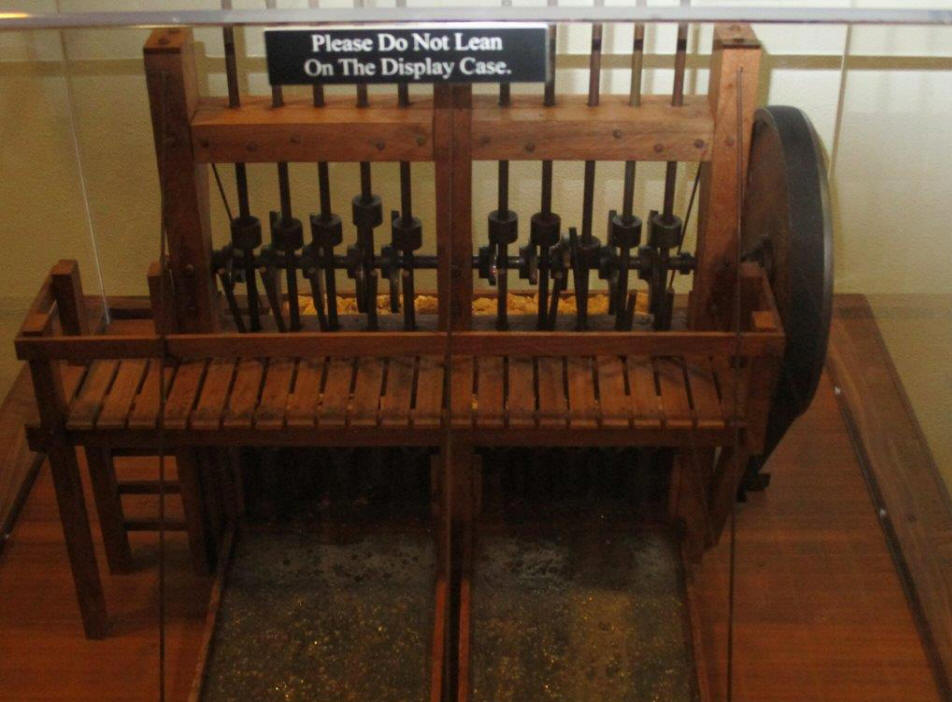 |
| A model of a complete stamp
mill. |
Prospectors out of the Charlotte
district explored the Appalachian foothills looking for more
gold. It is unknown who first unearthed gold in North Georgia
(there are several versions of the story), but it was discovered
near present-day Dahlonega in 1828. The first documented report
of a gold strike occurred in a Milledgeville (then the state
capital) newspaper from 1829:
| GOLD.—A gentleman of the first respectability in
Habersham county, writes us thus under date of 22nd
July: "Two gold mines have just been discovered in this
county, and preparations are making to bring these
hidden treasures of the earth to use." So it
appears that what we long anticipated has come to pass
at last, namely, that the gold region of North and South
Carolina would be found to extend to Georgia. |
The original gold rush town was
Nuckollsville, located about five miles southwest of Dahlonega,
and later named Auraria (Latin for gold). Auraria was a gold
stampede town and had a population of about 3,000; within a few
years the area had a population of 10,000. Later, in 1832, the
county seat of Lumpkin County was located at Dahlonega, as well
as a federal mint in 1838, and Auraria began a decline to a
ghost town. Benjamin Parks, one of the men who claimed to make
the first gold strike, later described the area as:
| The news got
abroad, and such excitement you never saw. It seemed within a
few days as if the whole world must have heard of it, for men
came from every state I had ever heard of. They came afoot, on
horseback and in wagons, acting more like crazy men than
anything else. All the way from where Dahlonega now stands to
Nuckollsville there were men panning out of the branches and
making holes in the hillsides. |
Cherokee Country
The name "Dahlonega" comes from the
Cherokee Indian word "ta-lo-ne-ga," meaning "yellow" or "gold."
The gold rush took place on Cherokee Indian reservation
lands. At first the federal government attempted to preserve
treaty rights and troops arrested gold miners and destroyed
their equipment. Soon the state saw the potential revenue from
the gold and used politics to gain control of the land.
President Andrew Jackson bolstered Georgia's land grab and
in1830 supported passage of the Indian Removal Act that led to
the "Trail of Tears" in 1838. Georgia gold has direct
connections to the forced migration of the Cherokee Nation to
Native Territory west of the Mississippi River. (For
more about Trail of Tears,
click here.)
Cherokee heritage is recognized in
Dahlonega at the Yahoole United Cherokee Museum and Education
Center. The center is fashioned in the traditional
seven-sided council house and shares Cherokee culture that is
oriented towards children. It features interactive and living
history displays, demonstrating things like Cherokee language,
the Trail of Tears, tools and weapons, local artifacts, a
full-scale Cherokee house, music, and a diorama.
Auraria
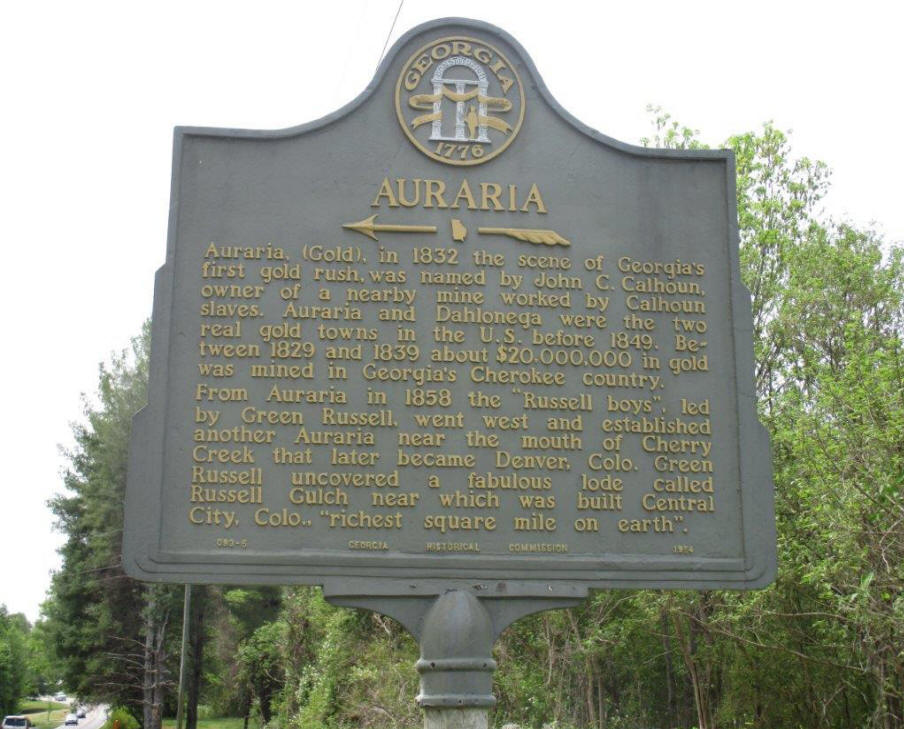 |
Auraria is now a ghost town. It
is on Google Map and easy to find.
A historical
marker shows the location. |
Auraria is a ghost town with a couple of
buildings still existing, plus a state historical marker that
reads:
| Auraria, (Gold), in
1832 the scene of Georgia's first gold rush, was named by John
C. Calhoun, owner of a nearby mine worked by Calhoun slaves.
Auraria and Dahlonega were the two real gold towns in the U.S.
before 1849. Between 1829 and 1839 about $20,000,000 in gold was
mined in Georgia's Cherokee country. From Auraria in 1858 the
"Russell boys," led by Green Russell, went west and established
another Auraria near the mouth of Cherry Creek that later became
Denver, Colo. Green Russell uncovered a famous lode called
Russell Gulch near which was built Central City, Colo., "richest
square mile on earth." |
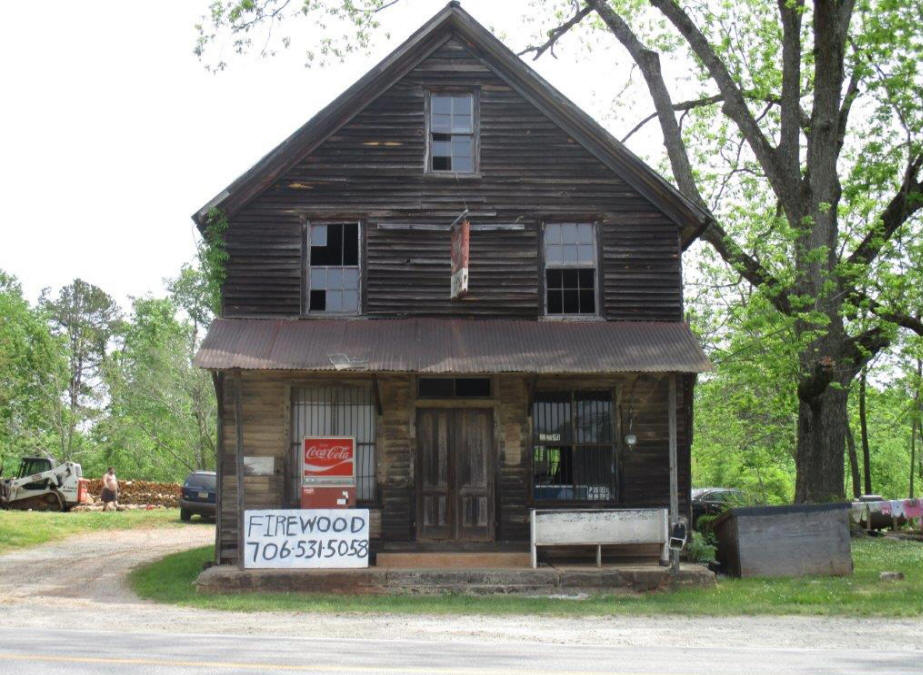 |
| This was originally a tavern
during the gold rush, later a general store, and now a
relic. |
Most people wouldn't consider Auraria
worth the short trip. The buildings are scattered among modern
structures and ghost town is an exaggeration. Still, it was kind
of cool to see a "ghost town" in the South. A merchant class was
responsible for Auraria; men who knew it was easier to mine gold
from the miner's pockets than from the ground. The town had 100
homes and dozens of stores, law offices, and taverns.
 |
| Originally this was the bank in
Auraria. |
Downtown Dahlonega
Downtown centers on the Dahlonega Gold
Museum State Historical Site. It is housed in the Lumpkin County
Courthouse built in 1836 (oldest surviving courthouse in
Georgia). It was built from clay bricks, hand-made from clay dug
from the nearby Cane Creek (notice small trace amounts of gold
in the bricks). The second story served as the courthouse and
the downstairs served various public uses (like a farmers'
market) over the years. Today the first floor is a Gold Museum
with displays that describe the gold rush history.
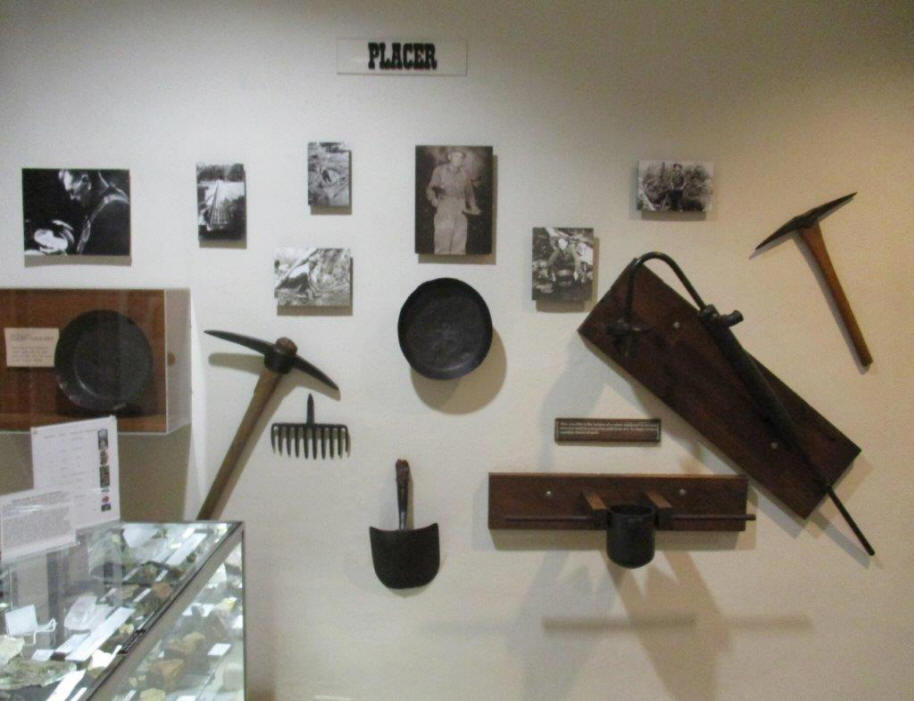 |
| Some of the tools that would have been used in gold
mining. |
There are several gold panning and
related gold mining adventures. The Consolidated Gold Mines
offers an underground tour of the largest hard rock gold mine
east of the Mississippi River.
The tour follows a massive tunnel network built over 100
years ago, complete with the original track system.
 1 1 |
| This is Drifter or pneumatic
rock drill. The mine is still full of interesting
equipment. |
Mining
equipment and techniques (like a demonstration of how miners
blasted quartz veins to uncover gold deposits). Part of the
ticket price includes a gold panning opportunity, but there are
plenty of other places to pan for gold.
 |
| The mine is dark in places. |
Today, Dahlonega is a tourist attraction
and Auraria is a ghost town. Both Charlotte and Dahlonega
produced enough gold to warrant establishment of branch mints.
The Dahlonega Branch Mint building burned in 1878 and
Prince Memorial Hall on the University of North Georgia campus
was built on its foundation. It is easy to identify; it is the
building with the steeple covered in Dahlonega gold leaf (just
like the state capitol dome). The town takes at least a day to
properly explore and is a delightful mixture of gold, mining,
and Native American history.
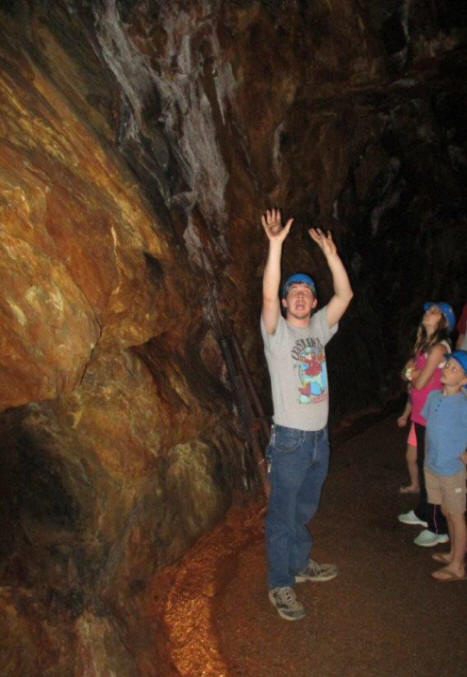 |
 |
The Consolidated Gold Mine Tour
is the highlight of Dahlonega. It is the largest hard
rock gold mine east of the Mississippi River. The tour
is 200 feet underground and over 100 years back in time.
The guide demonstrates how miners blasted quartz
veins to uncover gold deposits. |
The mine is not-so-dark in other
places. |
Author: Thomas J. Straka is a forestry professor at Clemson
University in South Carolina.
For
more information:
Digital Library of Georgia: "Thar's Gold in Them Thar Hills" -
Georgia Gold History:
http://dlg.galileo.usg.edu/dahlonega/history.php
Dahlonega Gold - A Brief History of the U.S. Branch Mint at
Dahlonega, Georgia:
http://www.dahlonegagold.com/dghist.htm
An
Illustrated History of the Georgia Gold Rush and the U.S. Branch
Mint at Dahlonega, Georgia:
http://www.goldrushgallery.com/dahlmint/c_history_outline.html
New
Georgia Encyclopedia: Gold Rush:
http://www.georgiaencyclopedia.org/articles/history-archaeology/gold-rush
Digital copy of Auraria:
The Story of a Georgia Gold-Mining Town by E. Merton
Coulter:
http://dlg.galileo.usg.edu/ugapressbks/pdfs/ugp9780820334974.pdf
Dahlonega Gold Rush Video:
http://www.todayingeorgiahistory.org/content/dahlonega-gold-rush
American Roads and
Global Highways has so many great articles you may
want to
search it for you favorite places or new exciting destinations.
|
![]() Ads fund American Roads and Global Highways
so please consider them for your needed
purchases.
If you enjoy the articles we offer, donations
are always welcome.
Ads fund American Roads and Global Highways
so please consider them for your needed
purchases.
If you enjoy the articles we offer, donations
are always welcome.
|